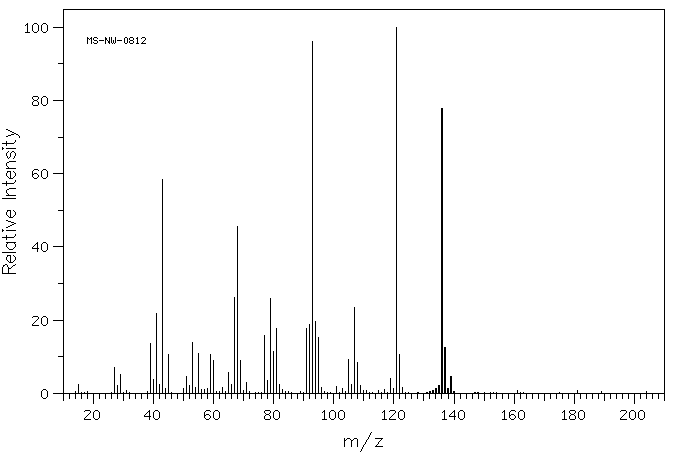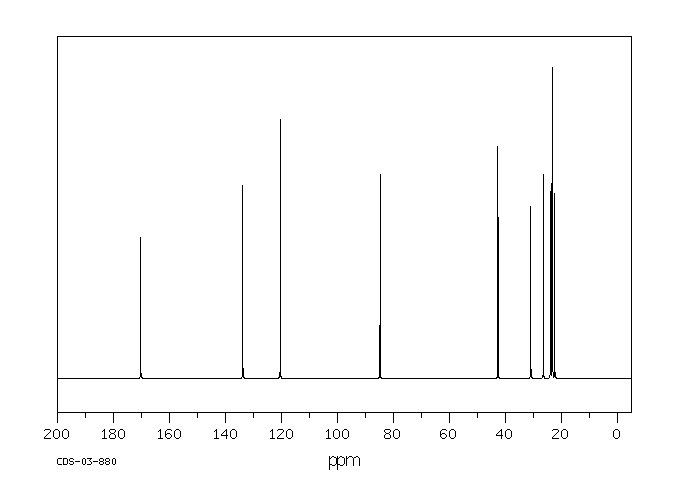乙酸松油酯 | 80-26-2
-
物化性质
-
计算性质
-
ADMET
-
安全信息
-
SDS
-
制备方法与用途
-
上下游信息
-
文献信息
-
表征谱图
-
同类化合物
-
相关功能分类
-
相关结构分类
物化性质
-
熔点:112-113.5 °C
-
沸点:220 °C (lit.)
-
密度:0.953 g/mL at 25 °C (lit.)
-
闪点:>230 °F
-
溶解度:DMSO:100 mg/mL(509.45 mM;需要超声波)
-
LogP:4.4 at 30℃
-
物理描述:Liquid
-
折光率:1.464-1.467
-
保留指数:1354;1350;1356;1333;1350;1329;1351;1350
计算性质
-
辛醇/水分配系数(LogP):2.4
-
重原子数:14
-
可旋转键数:3
-
环数:1.0
-
sp3杂化的碳原子比例:0.75
-
拓扑面积:26.3
-
氢给体数:0
-
氢受体数:2
安全信息
-
TSCA:Yes
-
危险品标志:Xi
-
安全说明:S26,S36
-
危险类别码:R36/38
-
WGK Germany:2
-
海关编码:2915390090
-
危险品运输编号:190kgs
-
RTECS号:OT0200000
SDS
制备方法与用途
乙酸松油酯自然存在于多种精油中,如柏木油、松针油、白千层油、小豆蔻油等。它呈无色至微黄色液体,带有柠檬香和薰衣草香。工业上通过在略高于室温的条件下使用醋酸酐对松油醇进行乙酰化,并在硫酸催化下制得。
应用乙酸松油酯可用作桃、梅、杏、树莓、樱桃、圆柚、中至、鼠尾草、小豆蔻等水果和香辛料以及柑橘类食用香精(ADI: 1mg/kg 每天,在中国境内按GB2760—1996标准执行);也可用于薰衣草、柠檬、森林、馥奇等调香。
含量分析根据酯测定法(OT-18)方法一,取样量为1g。回流时间改为4小时,计算中的当量因子(e)取98.15。或按气相色谱法(GT-10-4),用非极性柱方法测定,并按FCC规定测得值为两种异构体之和。
毒性GRAS(FEMA)。LD₅₀ 4160mg/kg(大鼠,经口)。
使用限量在软饮料中,最大使用量为3.5mg/kg;冷饮3.2mg/kg;糖果6.3mg/kg;焙烤食品15mg/kg;胶姆糖14~260mg/kg;调味品15mg/kg;肉类1.7~40mg/kg。适度为限(FDA§172.515,2000)。
食品添加剂最大允许使用量和最大允许残留量标准乙酸松油酯是一种食品用香料,在GB 2760—1996中规定可用于配制杨梅、樱桃、柑橘、桃等水果型食用香精。在口香糖中的使用量为14~260mg/kg;肉类1.7~40mg/kg;调味品15mg/kg;烘烤食品15mg/kg;糖果6.3mg/kg;软饮料3.5mg/kg;冷饮3.2mg/kg。也可用于香柠檬油、薰衣草油、橙叶油等香料的配制,常用于薰衣草、古龙、香薇、松针、辛香、柑橘香型香精中,并可用于食用香精如浆果、白柠檬、橙子、樱桃、桃子、梅子、杏子、辛香、肉香等。亦用于小豆蔻、百里香及其他调味精油以增强辛香香味。
化学性质乙酸松油酯为无色液体,具有木香花香味,不溶于水但易溶于乙醇、苯等有机溶剂。
用途主要用于调配薰衣草、古龙香水、香皂及食用香精等。是配制香柠檬油、薰衣草油、橙叶油等香料之一。
生产方法乙酸松油酯可由松节油与醋酐和无水醋酸钠反应,反应物用碱中和,再用水洗涤,分离干燥后减压蒸馏得成品。亦可通过在松节油中加入硫酸、醋酸的混合水溶液,在45~50℃下进行反应,然后在30~40℃下放置数小时,加水析出油层,并用碳酸钠溶液中和后再经减压蒸馏而制得产品。
上下游信息
-
上游原料
中文名称 英文名称 CAS号 化学式 分子量 松油醇 terpineol 98-55-5 C10H18O 154.252 -
下游产品
中文名称 英文名称 CAS号 化学式 分子量 —— 8-acetoxy-t-4-p-menth-1-en-7-ol 87578-92-5 C12H20O3 212.289 —— 3-cyclohexene-1-methanol, 5-hydroxy-α,α,4-trimethyl-α-acetate —— C12H20O3 212.289 —— (+/-) 4-(1'-acetoxymethylethyl)-1-methylcyclohex-1-en-6-one (8-acetoxyvotanacetone) 87578-93-6 C12H18O3 210.273 松油醇 terpineol 98-55-5 C10H18O 154.252 二氢松香醇醋酸酯 dihydroterpenyl acetate 80-25-1 C12H22O2 198.305 4-(2-羟基-2-丙基)环己烯-1-甲醇 7-hydroxyterpineol 5502-74-9 C10H18O2 170.252 —— 3-(1-acetoxy-l-methylethyl)-6-oxo-heptanal 212832-29-6 C12H20O4 228.288 反式-索布瑞醇 (-)-trans-sobrerol 71697-84-2 C10H18O2 170.252 —— (1R,5R)-5-(2-hydroxypropan-2-yl)-2-methylcyclohex-2-enol 54164-89-5 C10H18O2 170.252 —— 4-(1-acetoxy-1-methylethyl)-1-methyl-cyclohexane-1,2-diol 212832-31-0 C12H22O4 230.304
反应信息
-
作为反应物:参考文献:名称:α-羟基酸催化α-蒎烯合成松油醇摘要:我们报告了使用五种 α-羟基酸(柠檬酸、酒石酸、扁桃酸、乳酸和乙醇酸)作为催化剂用于从 α-蒎烯合成萜品醇。研究发现,仅在α-羟基酸催化下,蒎烯的水合速度较慢。由羟基乙酸、磷酸和乙酸组成的三元复合催化剂具有良好的催化性能。反应步骤是水解中间体萜品乙酸酯,生成萜品醇。最佳反应条件为:α-蒎烯、乙酸、水、柠檬酸和磷酸,质量比为1:2.5:1:(0.1-0.05):0.05,反应温度70℃ ,反应时间为 12-15 小时。α-蒎烯的转化率为96%,α-萜品醇的含量为46.9%,α-萜品醇的选择性为48.1%。此外,DOI:10.3390/molecules27031126
-
作为产物:描述:rac-2-[(1S,5R)-4-methyl-5-(1-tosylhydrazineyl)cyclohex-3-en-1-yl]propan-2-yl acetate 在 silica gel 作用下, 以 乙酸乙酯 为溶剂, 反应 24.0h, 以62.5 mg的产率得到乙酸松油酯参考文献:名称:用于还原脱氧的 m-C2B10H11HgCl/AgOTf 催化反应摘要:已开发出 m -C 2 B 10 H 11 HgCl/AgOTf 催化的烯丙基甲硅烷基醚与 N -Boc-N '-甲苯磺酰肼的反应。在温和的条件下,所得的烯丙基肼产物以良好的收率转化为裸烯烃。此外,使用过的m -C 2 B 10 H 11 HgCl 可以定量回收。DOI:10.1055/s-0036-1588554
文献信息
-
Aluminium dodecatungstophosphate (AlPW12O40) as a highly efficient catalyst for the selective acetylation of –OH, –SH and –NH2 functional groups in the absence of solvent at room temperature作者:Habib Firouzabadi、Nasser Iranpoor、Farhad Nowrouzi、Kamal AmaniDOI:10.1039/b300775h日期:2003.3.6AlPW12O40 was found to be an effective catalyst for the selective acetylation of alcohols, thiols, and amines in the absence of solvent at room temperature.AlPW12O40被发现是一种有效的催化剂,可在室温无溶剂条件下选择性乙酰化醇、硫醇和胺。
-
p-Toluenesulfonyl chloride as a new and effective catalyst for acetylation and formylation of hydroxyl compounds under mild conditions作者:Ardeshir Khazaei、Amin Rostami、Fatemeh MantashloDOI:10.1016/j.cclet.2010.05.025日期:2010.12The catalytic application of p-toluenesulfonyl chloride for efficient acetylation of various types of alcohols and phenols with acetic anhydride in solvent-free conditions is reported. Also structurally diverse alcohols were formylated using formic acid based on the use of catalytic amount of p-toluenesulfonyl chloride under solvent-free condition. The reactions were carried out in short reaction time
-
Complementary and selective oxidation of hydrocarbon derivatives by two cytochrome P450 enzymes of the same family作者:Md. Raihan Sarkar、Stephen G. BellDOI:10.1039/d0cy01040e日期:——The cytochrome P450 enzymes CYP101B1 and CYP101C1, which are from the bacterium Novosphingobium aromaticivorans DSM12444, can hydroxylate norisoprenoids with high activity and selectivity. With the goal of expanding and establishing their substrate range with a view to developing applications, the oxidation of a selection of cyclic alkanes, ketones and alcohols was investigated. Cycloalkanes were oxidised细胞色素P450酶CYP101B1和CYP101C1,来自细菌新孢子虫DSM12444可高活性和选择性地羟基化类异戊二烯。为了扩展和建立其底物范围,以开发应用,研究了选择环烷烃,酮和醇的氧化。环烷被氧化,但两种酶均显示出中等的结合亲和力和较低的生产活性。我们通过将组氨酸残基切换为苯丙氨酸(H85F),使活性位点更具疏水性,从而改善了这些底物与CYP101B1的结合和活性。环烷烃骨架中酮部分的存在显着改善了两种酶的氧化活性。CYP101C1优选在C-2位置催化环烷酮的氧化,而CYP101B1在远离羰基的位置以较高的生产率氧化这些底物。这表明每种酶的活性位点中环酮的结合方向必须不同。线性酮也被两种酶氧化,但活性和选择性较低。CYP101B1比CYP101C1更有效地氧化具有酯导向基团的环状底物。两种酶都在远离酯导向基团的环系统上以高区域选择性催化这些酯的氧化。CYP101C1比CYP101B1
-
STRONGLY LEWIS ACIDIC METAL-ORGANIC FRAMEWORKS FOR CONTINUOUS FLOW CATALYSIS申请人:The University of Chicago公开号:US20210053042A1公开(公告)日:2021-02-25Lewis acidic metal-organic framework (MOF) materials comprising triflate-coordinated metal nodes are described. The materials can be used as heterogenous catalysts in a wide range of organic group transformations, including Diels-Alder reactions, epoxide-ring opening reactions, Friedel-Crafts acylation reactions and alkene hydroalkoxylation reactions. The MOFs can also be prepared with metallated organic bridging ligands to provide heterogenous catalysts for tandem reactions and/or prepared as composites with support particles for use in columns of continuous flow reactor systems. Methods of preparing and using the MOF materials and their composites are also described.
-
Permanganate–periodate oxidation. Part VIII. The oxidation of some cyclic mono-olefins and monoterpenes作者:T. Suga、E. von RudloffDOI:10.1139/v69-607日期:1969.10.1
The reaction of cyclic mono-olefins with the permanganate–periodate reagent was investigated. 4-Terpinenol and its acetate, and to a lesser degree α-terpineol and camphene gave in addition to the expected products, several neutral and acidic products. In contrast, α-pinene, β-pinene, sabinene, pulegone, and several cyclo-olefins which can be considered as simple analogues of these monoterpenes, afforded the predicted products in high yield. Cyclo-hexanone and menthone, though saturated, were oxidized extensively, enolization offering a plausible pathway for this result. Saturated terpene alcohols reacted only very slowly indicating that attack at a tertiary hydrogen is not a significant part of the permanganate–periodate reaction.
表征谱图
-
氢谱1HNMR
-
质谱MS
-
碳谱13CNMR
-
红外IR
-
拉曼Raman
-
峰位数据
-
峰位匹配
-
表征信息










